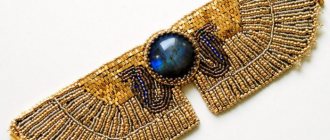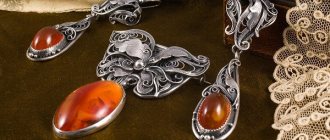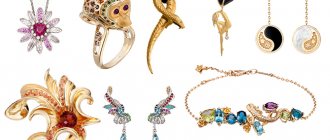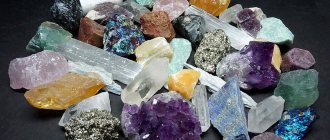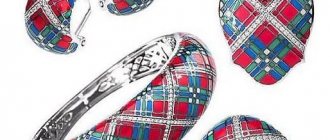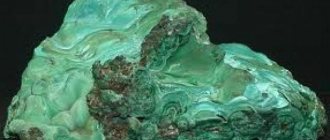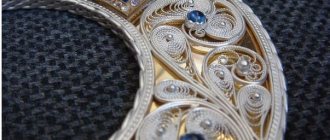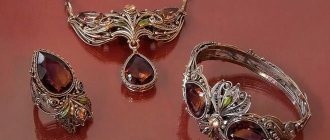The creation of jewelry and household items from precious and semi-precious materials is an ancient decorative and applied art, manifested in man’s eternal desire for harmony and beauty. Making jewelry at home is a skill with a subtle understanding of the properties of the material, the ability to create objects for aesthetic pleasure.
Filigree
You've heard the word "filigree" and always associated it with the meaning of "particularly careful" and "attentive to detail." You are absolutely right.
Filigree is a jewelry technique that is used by experts to create patterns from thin silver or gold wire. Filigree patterns can be in the form of herringbones, ropes, weaving and other patterns. This jewelry work is done under a microscope.
The term "filigree" has Latin roots. It comes from the words filum - “thread” and granum - “grain”. There is also a native Russian analogue - filigree jewelry technology. This word comes from the Old Russian “s’kati”, which means “to twist” or “to twist”.
Filigree is found both in jewelry and in boxes, vases and even on the hilts of ancient swords.
If you see a similar pattern on a piece of jewelry, you know that it is filigree.
The most famous jewelry masters
The names of the vast majority of skilled jewelers of antiquity are forever lost to posterity and only a few of them are familiar to a narrow circle of specialists. Many creative individuals who worked with precious stones and metals made a significant contribution to world culture. And yet, some of the most famous jewelry masters include:
- Karl Faberge is a Russian jeweler of German origin, the founder of the famous dynasty of Easter egg makers for the Romanov imperial family. It took a team of craftsmen led by Carl Faberge a whole year to create one masterpiece, but each egg today represents enormous artistic value.
- Charles Lewis Tiffany is the founder of a huge transnational jewelry company named after him. Tiffany was not only a talented jeweler, but also a successful entrepreneur, and the company he created is now worth more than $16 billion.
- Daniel Swarovski is an Austrian engineer who created a world-famous gemstone processing company - a leader in the world market for cut crystal. Today, Swarovski crystals are used by the best designers and fashion designers when developing luxury clothing collections.
- Louis-François Cartier is a French jeweler, founder of the Cartier company and a huge network of specialized stores around the world. His company gained worldwide fame later, thanks to the development of watches decorated with precious stones by his grandson.
Today, jewelry making is still a sought-after art form. Unique masterpieces of ancient masters decorate the halls of the best museums in the world and the private collections of the richest people on our planet. And ordinary people, whenever possible, buy mass-produced jewelry for themselves and loved ones.
Diamond cut
This is a modern technique for processing precious metals. Its principle is that gold and silver are processed at a special angle by special cutters at different depths. After applying a diamond facet to the jewelry, the finest patterns are obtained that sparkle in any light, like real diamonds.
Enamel
The word has Greek roots and means “I mix.” In jewelry, enamel is the creation of designs on enamel. Jewelry enamel is not ordinary. It consists of transparent or opaque lead glass that covers the products.
Enamel is used on crosses, images of saints, icons and other similar objects. This is an excellent decoration that ensures longevity of jewelry.
It is thanks to enamel that icons are stored for so long that after hundreds of years they retain their original qualities and become antique.
Blackening
The word “blackening” itself already describes the process and result of the artistic technique. It consists in applying a special mixture (niello) to the relief of the jewelry.
The result is an effect that creates a contrast between the color of the precious alloy and the black mass inside it. Blackening gives the jewelry a special beauty and protects the jewelry from chemical influences.
The most popular metal for blackening is silver. Sometimes jewelers also blacken gold, but do not carry out such treatment with other precious metals.
Core Technologies
Jewelry production technology is divided into serial and individual methods. It consists of several main processes:
- Melting, casting and rolling.
- Rolling and drawing.
- Cold stamping.
To obtain a precious metal of the required standard, it is fused with alloying components. Melting is the transformation of a solid material into a liquid state or melt. In this state, metals are poured into special containers to give them the desired shape. This process is called casting.
Rolling of the resulting ingots is carried out to obtain metal wire and sheets with the required cross-section and thickness. Rolling produces profiles of various shapes - oval, round or square. Wire drawing is done using diamond dies. After this, it is used in filigree objects.
Stamping is the processing of metal surfaces using pressure. For this process, special devices called stamps are used. One type of cold stamping is embossing, which can be mass-produced or hand-made.
To protect objects from corrosion, galvanic coating and oxidation are used. The electroplating method involves gilding or silvering the surface, and the thickness of the layer depends on the type of decoration. The finished product is oxidized with sulfuric acid, after which a colorless varnish is applied.
If the jewelry is complemented with precious or semi-precious stones, then the ability to secure the stone plays a special role. The beauty and play of light in the stone, as well as the cost of the item, depend on the talent of the master and the method he chooses. Jewelry manufacturing technology includes the main fastening methods:
- The prong method is fastening using prongs that act as clamps. The stones are set into both castes and metal.
- The core method is intended for casteless fastening of one or more stones. A hole is drilled in the product, and stones are placed in them using metal particles or punches. The edges are treated with a grisant finish and have a fine notch.
- Blind crimping is characterized by crimpless fastening into castes and looks like a metal edging that crimps the stone around its entire circumference.
In the case of using stones that do not have precious status, as well as glass and marcasite products, an adhesive base can be used to attach them. Pearls and corals with incomplete holes are secured using glue.
Classification by technology and purpose
Jewelry products are usually classified according to their functional purpose and execution technique. Their cost largely depends on the latter. The main classes include various decorations, writing and toiletries, dishes, furniture, interior decoration items and souvenirs.
According to technical design, they are divided into three types: individual, machine and combined production. Doing it manually takes a lot of effort and time, and each product is unique, which is why the cost of such work is the highest.
Production using special equipment consists of performing basic processes and operations. Nevertheless, at the final stages it is impossible to do without human participation. Combined production looks similar. The most difficult and painstaking part of the work is performed by people, bringing machine-made parts to perfection.
Tools and equipment
A modern jeweler needs not only skills and knowledge, but also equipment for making jewelry, which includes the following items:
- Carpentry equipment (fixing vices, sets of files and needle files, cutters, drills, pliers, scissors, tweezers, wire cutters).
- Grinding equipment (a set of thread, metal and bristle brushes, polishing and grinding machines, flannel and canvas wheels).
- Optical instruments (magnifying glasses, microscopes) are required when working with small objects, as well as when cutting stones.
- A set of chemical reagents (acids, alkalis, salts). They are used to dissolve and process metals.
- Table scales equipped with weights.
In addition to tools, the room and workplace of the master play an important role. The workshop must have several rooms with exhaust ventilation. One room is equipped as the main place for work, the second is used to carry out necessary operations related to the release of harmful substances. Casting mechanisms and smelting furnaces are also located there. Drum and centrifugal tumbling are used in the final processing of products.
For successful work, the master also needs stationery (a set of simple pencils with an eraser, whatman paper, watercolor paints and brushes), since jewelry creativity is not complete without first creating sketches of the future masterpiece.
Engraving
Engraving is the application of a design, ornament or inscription to a piece of jewelry. The engraving result is always in relief. One part of the pattern has a recess, and the other is convex.
Previously, every jeweler applied engraving using special cutters. This work was long and difficult. Microscopes have simplified the process somewhat, but not to perfection.
Nowadays all major jewelry companies do 3D engraving. Its essence is as follows. Designers give programmers the design they want to see in the image. The developers write a special program, thanks to which lasers apply the desired pattern in a matter of seconds.
You can talk endlessly about how hand engraving is done with passion, but you must agree: in any case, the program applies the edges with maximum precision. The end result is that you are wearing a perfectly engraved piece of jewelry.
The unknown history of technology using the example of jewelry
Classical history, which is generally accepted by historians, has some gaps from an engineer's point of view. Scientists themselves are reluctant to admit that the sources of information are either chronicles written for the benefit of the writer, or burials in which they placed what religion prescribed. Incredibly valuable for science are cases when some cataclysm like the eruption of Vesuvius instantly buried two cities, or on a small scale - in a city battle in ancient Ryazan, both residents and conquerors found themselves under the rubble of burning huts, and then the survivors did not dismantle the rubble. But, extrapolating into the past the experience of wars of the 20th century, it is easy to notice that some valuables and important means of production are removed from the front line at any cost, no matter what. What valuables were there? Entire factories with multi-ton machines were sent for evacuation. An example of this is that only a few examples of ancient blacksmith tools have been found on the territory of the USSR, although hundreds, if not thousands, of metallurgical furnaces and forges are known in excavations. Everything is very simple - in ancient times there was little iron, it was expensive, no matter what - in workdays to dig, smelt, forge, or in some units of exchange from bags of flour to money of all known types. Therefore, blacksmith tools were either taken with them when they fled, or passed from father to son if life was peaceful. Steel products rust in the ground, or they are too utilitarian to survive in everyday life without use for thousands of years.
Jewelry is another matter. In the earth they are unchanged, and if they are in someone’s treasury, they can also pass from generation to generation unchanged. It is reliably known that the residents of Mari-El wore wedding jewelry of the 15th century, passed from daughter to daughter and worn only at weddings. But if you look at ancient or antique “jewelry” from the point of view of a master, serious questions arise about what is not yet known to historians from finds - about technologies and tools in jewelry since ancient times. For example, I became confident that in Ancient Rome they not only knew lenses, but also knew how to melt transparent glass and make lenses of fairly large diameters specifically for working with magnification. I will elaborate on my statement below. Let's start with Ancient Rome and Greece, or rather with their coins. The portraits of the emperors bear an excellent resemblance to the larger busts; moreover, the portraits of the same long-reigning character change with age, as should be the case if they were made from the original. But individual elements there are less than one tenth of a millimeter.
And you can’t do this without optics. A little reconstruction had to be done here. The author mounted lenses of various diameters on a tripod to determine what diameter was the minimum to work with comparable accuracy - it turned out that a lens with a minimum diameter of 90 mm was needed, which is common among embroidery magnifiers. It is convenient to work under a 120 mm magnifying glass. Magnification is also an issue - for jewelry binocular microscopes the minimum is 8x, the maximum for studying stones is up to 60x. So, whatever one may say, the ancient Greeks, who made stamps for coins, had magnifying glasses of decent size and quality glass. Why they were not preserved is also clear. What wasn't broken was taken away. Sooner or later, what was stolen was either thrown out, or children got to it, the rest is clear. But that is not all. Tools for fine work also have to be sharpened under optics, using fine abrasives. Conclusion - grinding the optical quality of lenses became available, even in minimal quantities, back in the days of the ancient Greeks.
Briefly about lens grinding. First, a glass blank of a certain diameter is cast, which is cooled very slowly so that there are no internal stresses. Then the faceplate comes into play - a flat disk rotates on a vertical spindle, onto which abrasives are applied, and the lens is ground with it, obtaining a plane on one of the sides. The material of the disc ensures the introduction of abrasive into it, the so-called caricature. For example, this is copper, bronze, cast iron of some brands and even end cutting of wood. After obtaining the desired shape, the lenses proceed to increasingly fine grinding, changing both abrasives and faceplates. Then the hard part is getting the convex lens. This is a separate and quite complex machine, in which, in addition to the rotation of the lens blank on a vertical spindle, there is also a complex trajectory movement of the grinding disk, which rotates along its axis at a certain speed that differs several times from the speed of the main spindle, and at the same time writes out ellipses (orbits) moving half or more off the lens blank. Moreover, these processes occur with the supply of water and fresh abrasive, and the removal of used abrasives. Then again change the abrasive to a finer one and replace the polishing pad, which is already clogged with coarse abrasive. And there can be dozens of such stages of polishing. One lens with a diameter of 12-15 cm could require several months of labor. This figure is from the experience of amateur astronomers - the telescope mirror was made on weekends and evenings for about a quarter and up to six months. Of course, the ancient Roman had more time, but there were no electric motors in the machine. Now let's return to our homeland, or rather, let's look at the ancient Scythians. Their “Perm animal style” of the 7th century. BC e. - XII century n. uh is known everywhere. Archaeologists recognize that the manufacturing technology was casting, usually in an earthen mold or using a lost wax model. Most of the finds have rather rough large features, indicating work with the naked eye.
Or here are decorations from the middle Oka in the fifth century AD:
(photo by the author, taken in the museum) But the Crimean Scythian decoration in the form of a hryvnia, included in the title - the quality of the details is simply amazing. It is clear that this golden object was most likely made by the best master in his region, but... Crimea was then a Roman colony. This fantastic thing tells us not only that magnifying glasses were used to make a wax model, but also that casting technology is not so simple. There are only three casting methods according to the model: - centrifugal, - vacuum, - vacuum plus pressure above the melt.
Now there are also combined installations, where the entire centrifugal casting process takes place in a vacuum or inert gas. But how could the Scythians pour in Crimea? It is easier to build a centrifuge, only for the hryvnia the flask will have dimensions close to the size of a bucket. Accelerating a 20-30 kg load to the required overload in half a second requires both a robust centrifuge design and a powerful drive capable of “switching on power” within a fraction of a second. The source of power could be either gravity, for example, a rope was wound around the axis of a centrifuge stopped by a counterweight, thrown over pulleys - one near the mechanism, the second under the ceiling, and loads, such as sandbags, were hung on the rope under the ceiling. Then they placed the flask on the table, secured it, poured in the metal and released the stopper. Another option is the use of elastic forces, known from throwing machines, in which case the rope from the axis would go to, for example, the top of a tree. Several people turned the centrifuge with their hands, winding the rope and tilting the tree, then stopped it and prepared for casting. The main disadvantage of a centrifuge is that if the flask is destroyed or the table is turned jammed, the metal will splash out with great speed and fly somewhere. And when there is gold there, more than one hundred grams, it will be a very offensive incident - in addition to the high cost of the metal, a fiery drop can kill a person or burn down a building. And it will fly so far that finding it will be very problematic - the flight range will be comparable to a throw from a sling, that is, the first hundreds of meters. The second problem is an axial bearing with very low friction, and at the same time very resistant to both sudden acceleration and eccentricity of the rotating part.
Could vacuum casting have been used in ancient times? At first glance, this is simply a fantastic statement. But... the Greeks had pumps to create increased pressure - without them the flamethrower would not shoot burning oil, and the “aeroton” throwing machine described by Ctesibius would not work. And if there is a high-pressure pump, then anyone who held the pump in their hands and had a little free time for pampering could discover the existence of a vacuum. The Greek army was conscripted, so after demobilization, the flamethrower could return to his father’s workshop and remember how he played around with the pump, closing the suction hole with his finger, or joked with a friend, using a straw to deprive him of the contents of a mug. And there it was not far from the idea of sucking the melt into the mold. And then the inquisitive mind of a craftsman, accustomed to precise work. And another secret is ready.
So, here we simply need methods for making tubes, for example from copper. By the way, in jewelry making, tubes are bent from strips and soldered lengthwise - maybe this is how parts of flamethrowers and vacuum foundries were made in ancient times? The next component of casting is the mold mixture. There are no questions here at all - gypsum and alabaster were used very widely, and trying to add sand and sawdust to them is also easy to guess. Model waxes - everything is a little more complicated here. Beeswax is too fusible and too sticky under normal conditions. The author’s hypothesis that they worked with the model at low temperatures, for example in a poorly heated workshop from autumn to spring, and in Crimea even on the street, seems acceptable - for a peasant, craft is a secondary matter, in the summer agricultural work, and in the winter you can do handicrafts. But it was good at the latitude of Plyos, and not Feodosia. Another option is that the jewelers did not freeze, but acquired ozokerite mountain wax through expeditions or orders from merchants. Its deposits are on the island of Cheleken (Caspian Sea), in the Caucasus, on Lake Baikal, near Tashkent, and deposits of ozokerite are located on both sides of the Carpathians, but the only places where ozokerite is mined here are the cities of Borislav (Lviv region, Ukraine), Starunya and Dzvinyach (Ivano -Frankivsk region, Ukraine). Finds of ozokerite are known in Mailisai in the Fergana Valley. It also seems not very far from Crimea. Could model waxes based on ozokerite be used? We are unlikely to find out. The reserves of materials in a single workshop were unlikely to be large, and waxes burn, so even if contemporaries did not burn them, the chance of finding a lump of model wax on the site of an ancient workshop is almost zero. Now let’s try to summarize what technologies provided the above:
Precise turning of bearings for a lens grinding machine, understanding the kinematics of its operation.
Ability to prepare abrasives of different grain sizes.
The ability to seal vessels for both excess and negative pressure (it was not for nothing that the Greeks assigned a separate god Hermes to the profession of sealing joints).
Plus some little things - fine-grained steel for coin dies and engraver's tools. A method for producing crucible steel with a high carbon content and low grain size.
The ability to harden steel without oxidation.
These are the thoughts that ancient jewelry prompted me to think about...
Rhodium plating
Rhodium plating is the application of a thin layer of the precious metal rhodium to a product. This procedure is necessary to give the jewelry hardness and a particularly bright white color. You remember that gold and silver are soft metals, right?
Rhodium is a durable metal with amazing reflectivity. It keeps its shine much longer than gold and silver, so it costs several times more.
Never confuse noble rhodium with the radioactive chemical element radium. Rhodium is a safe and very expensive metal!
Mokume Gane
Mokume Gane is an artistic technique that came to us from Japan in the 18th century. The technique involves giving the jewelry a woody structure. Professionals achieve this effect by layering precious metals and copper of different colors on top of each other. The result is a product that cannot be created from ordinary metal.
History of origin and development
Since prehistoric times, people have had a need for jewelry. The most primitive objects were made from shells, animal bones, and colored minerals. The most ancient crafts date back about 100 thousand years; they were found on the territory of modern Israel. Ancient people made amulets from the stones they found, giving them magical meaning.
After several thousand years, people learned to process materials, and a direction called glyptics appeared. This type of creativity is associated with carving on semi-precious or precious stones. The first developments in the extraction and cutting of stones with diamonds date back to this period.
With the development of trade, production expanded, workshops and small factories appeared. Craftsmen kept their secrets and passed them on only to their heirs or students. Guilds of craftsmen were born in the Middle Ages. This type of creativity gradually ceased to be a craft. The manual method of processing precious stones and metals made it possible to create unique works. The most famous jewelers were close to royalty; the jewelry they created was available only to the richest people.
The transition to mass production of jewelry occurred at the end of the 19th and beginning of the 20th centuries. The century of industrialization and industrial development was marked by the creation of the synthesis of artificial materials. With the increase in the production of such crafts, the cost of natural minerals, stones, and metals increases. This still happens today.
Russia has a rich history of the development of this type of creativity. During archaeological excavations, unique and amazingly beautiful jewelry is found that is several thousand years old. The heyday of creating works of art from precious metals and stones occurred during the reign of the Romanov dynasty.
At the beginning of the twentieth century, a revolution occurred, and this type of production fell into decline. In the Soviet Union, gemology was declared bourgeois, and jewelry - an excess. Mass production was made from synthetic corundum and had no relation to art recognized in the civilized world. In addition, Soviet ideology prevailed in all subjects.
Characteristics of jewelry materials
Craftsmen use different materials for their work, depending on what item is being performed. They are divided into the following types:
- Metal elements are represented by non-ferrous, noble metals and their alloys.
- Non-metallic - these are semi-precious, precious and ornamental minerals, plastic, rubber, ceramics, porcelain, glass.
Minerals of artificial and organic origin are used for medallions, earrings, and rings. Animal bones and horns, shells, wood and leather are used in the production of souvenirs.
Metals and alloys
The most popular among craftsmen are metals that have the status of noble. This is explained not only by their natural beauty, but also by their unique properties. Sometimes they are used without additives, but more often - in combination with other elements. These include the following metals:
- Gold has a beautiful yellow tint, is soft, malleable and chemical resistant. For the production of various jewelry, it is used in the form of alloys with special alloying additives that give the metal blue, red, green, and white shades.
- Silver. The main advantages of this ductile metal are its reflectivity and malleability. It is resistant to moisture and strong acids. In jewelry it is used in an alloy with copper. They decorate the interior with it and make dishes from it.
- Platinum is a very refractory metal with a silvery tint. The degree of hardness is higher than that of silver and gold. Attracts specialists with its play of color, durability and plasticity. Platinum jewelry is very elegant and elegant.
Elements belonging to the platinum group - rhodium, palladium, ruthenium, osmium - have found their application in industry. As an additional component they are used with white gold and platinum.
Pure metals are rarely used in the jewelry industry due to their high cost, insufficient wear resistance and low hardness. These disadvantages are eliminated with the help of alloys. Alloying elements in gold alloys are silver, zinc, cadmium, copper and platinum group elements. The main metal in silver alloys is copper, sometimes nickel, aluminum, and zinc. The following alloys are considered the most popular:
- Brass - the main metal in this alloy is copper with zinc, lead, iron, and tin. Easily processed by cutting and pressure.
- Bronze is based on copper and components such as silicon, aluminum, tin, beryllium, manganese, nickel, cadmium, zinc. Beryllium bronze is the most elastic, hard and corrosion resistant. Badges, medals, and souvenirs are made from it.
- Nickel silver with copper, zinc and nickel in its composition. Tough, corrosion resistant and ductile. Jewelers use it for filigree jewelry.
- Cupronickel is a beautiful alloy with a silvery color. Consists of copper and nickel. It lends itself well to stamping, cutting, polishing, and soldering, so it is very popular among jewelers.
Alloying metals make the raw material more ductile, malleable and change the color of the main element. An additional advantage of alloys is their resistance to corrosion.

